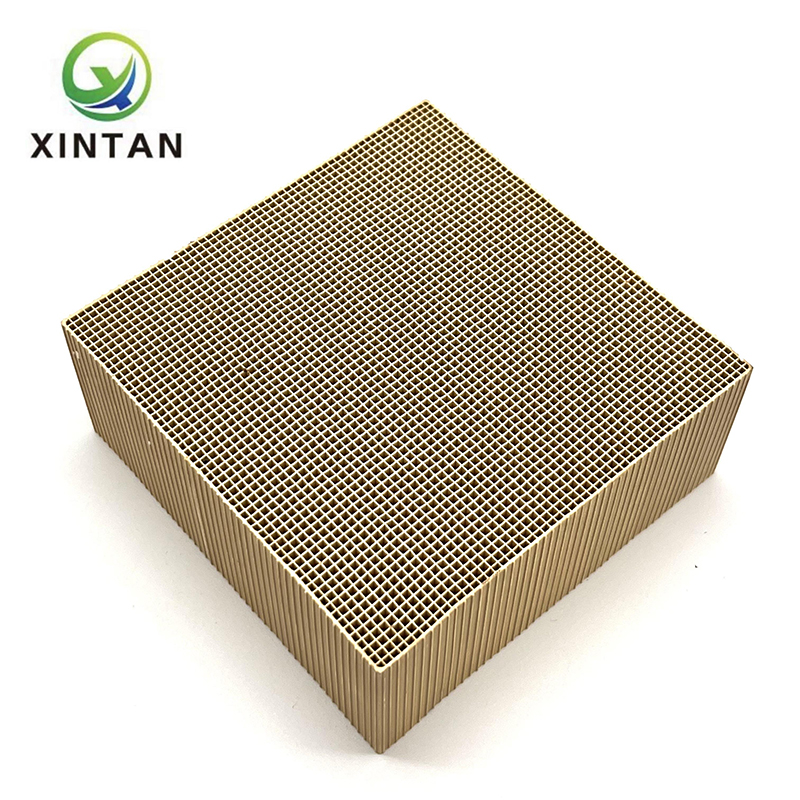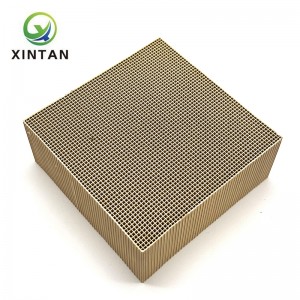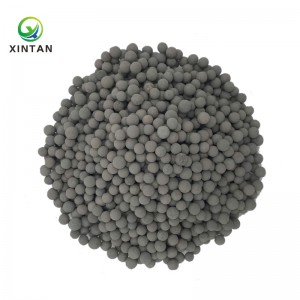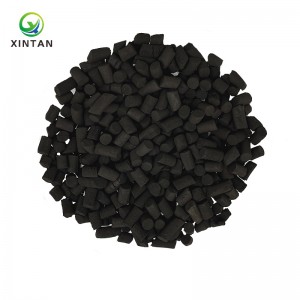VOC catalyst with Noble metal
Main parameters
| Active ingredients | Pt, Cu, Ce, etc |
| GHSV(h-1) | 10000~20000 (according to actual operating condition) |
| Appearance | Yellow honeycomb |
| Dimension (mm) | 100*100*50 or customize |
| Active load | Bullion content: 0.4g/L |
| Operating temperature | 250~500℃ |
| Maximum short-term temperature resistance | 800℃ |
| Conversion efficiency | >95% (Final result according to actual operating condition) |
| Air speed | <1.5m/s |
| Bulk density | 540 ± 50g/L |
| Carrier | Cordierite honeycomb, square, 200cpi |
| Compressive strength | ≥10MPa |
Advantage of VOC catalyst with noble metal
a) Wide range of application. VOC catalyst with noble metal is widely used, such as spraying, printing, glass fiber reinforced plastic, UV paint, pharmaceutical, chemical, petrochemical, enamelled wire exhaust gas industry applications. The composition of waste gas in the printing industry is relatively simple, and the main components include benzene series, esters, alcohols, ketones and so on.
b) High treatment efficiency, no secondary pollution. The purification rate of organic waste gas treated by catalytic combustion method is generally above 95%, and the final product is harmless CO2 and H2O, so there is no secondary pollution problem. In addition, due to the low temperature, the generation of NOx can be greatly reduced.
Shipping,Package and storage

a) Xintan can deliver VOC catalyst with noble metal below 5000kgs within 7 days.
b) Packaging: Carton box
c) Keep in an airtight container, prevent contact with air, so as not to deteriorate
Applications of VOC catalyst with noble metal
VOC catalyst with noble metal is widely used in the following industrial fields: petrochemical, chemical, spraying, printing, coating, enameled wire, color steel, rubber industry, etc.
Remark
- In the process of catalytic combustion reaction, sufficient oxygen should be guaranteed to react with VOCs. When oxygen is insufficient, the purification efficiency of waste gas will be directly affected, resulting in carbon black and other by-products attached to the surface of the catalyst, resulting in catalyst inactivation.
-The waste gas shall not contain sulfur, phosphorus, arsenic, lead, mercury, halogens (fluorine, chlorine, bromine, iodine, astatine), heavy metals, resins, high-boiling point, high-viscosity polymers and other toxic chemical elements or substances.
- The catalyst should be handled gently, and the direction of the catalyst hole should be consistent with the direction of the air flow when filling, and placed closely, without gaps.
-Before entering VOCs gas, it is necessary to enter flowing fresh air to fully preheat the catalyst (preheat to 240℃~350℃, set according to the highest temperature required by the most difficult gas in the exhaust gas component).

The optimal operating temperature of the catalyst is 250~500℃, the exhaust gas concentration is 500~4000mg/m3, and GHSV is 10000~20000h-1. It should be avoided as far as possible to avoid the sudden increase of exhaust gas concentration or the long-term high temperature of catalyst above 600℃.
- At the end of the operation, firstly cut off the VOCs gas source, use fresh air to continue heating for 20 minutes and then shut down the catalytic combustion equipment. Avoiding catalyst in low temperature contact with VOCs gas, can effectively prolong the service life of catalyst.
- The dust content of exhaust gas should not be exceed 10mg/m3, otherwise it is easy to cause the blockage of catalyst channel. If it is difficult to reduce the dust to the ideal state before treatment, it is recommended to regularly remove the catalyst and blow it with an air gun before use, without washing it with water or any liquid.
- When the catalyst is used for a long time, there is a certain decrease in activity, the catalytic bed can be switched before and after or up and down, or the operating temperature of the catalytic chamber can be appropriately increased.
- When the temperature of the catalytic furnace is higher than 450℃, it is recommended to start the supplementary cooling fan and fill cold air to cool the catalytic furnace to protect the catalyst.
- The catalyst should be moisture-proof, do not soak or rinse with water.













